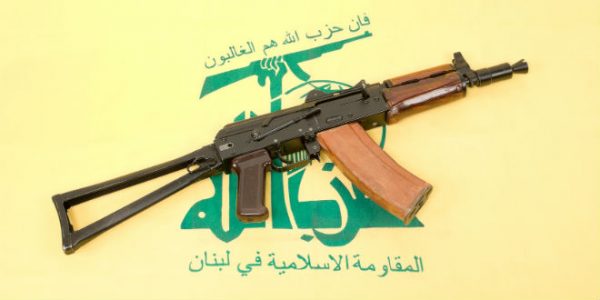 Between Syria’s civil war and Tehran’s escalating standoff with Israel, Lebanon’s Hezbollah group has been busy lately. Now, analysts say, the Iranian-backed militia’s members are coming home. Mark MacKinnon investigates what they’re returning to, and why
Between Syria’s civil war and Tehran’s escalating standoff with Israel, Lebanon’s Hezbollah group has been busy lately. Now, analysts say, the Iranian-backed militia’s members are coming home. Mark MacKinnon investigates what they’re returning to, and why
Standing on a hill overlooking Lebanon’s border with Israel, Talal Saad is telling his brother, visiting from Germany, tales of the last war between Israel and the Hezbollah militia − and the destruction that was wrought in the south of this country.
The border is quiet now, and has been for most of the intervening 12 years. But few things in the Middle East feel permanent these days, as the multisided war in Syria grinds on and the risk of a major clash between Israel and Hezbollah’s main backer, Iran, grows larger.
The seven-year-old conflict in Syria has grown into something like a mini-world war in recent months, further dragging regional and global players into the fray at an alarming pace. The United States and its allies Britain, France and Saudi Arabia stand on one side of the conflict, seeking to isolate and perhaps topple the regime of Bashar al-Assad, who is backed by Russia and Iran, both of which have forces on the ground to support Mr. al-Assad. There’s a separate, but related, conflict in the north of the country, pitting Turkey’s army against a Kurdish militia that it considers to be a “terrorist” group, while Turkey’s NATO allies the United States and France support the same Kurds in a fight that has pushed the Islamic State to the brink of defeat.
But none of those dynamics is as flammable as the confrontation between Israel and Iran. And Tehran’s firmest ally in any fight with the Jewish state would be Hezbollah, the Shia militia − called “terrorist” by Canada and the United States − that is the dominant military and political force in Lebanon, a country with fading hopes of staying out of the fighting that surrounds it.
Hezbollah is armed and funded by Iran, and for the past six years it has fought on the side of Mr. al-Assad’s forces, helping prevent the collapse of the regime. There are reports Hezbollah fighters have also been dispatched to help train pro-Iranian forces in Iraq and Yemen. Now, Lebanese analysts say, with the Syrian regime increasingly gaining control over the country, Hezbollah is starting to bring the bulk of its fighters home. The question hanging over Lebanon and the region is what Hezbollah intends to do with them next.
In the valley below the road the two brothers paused on, Israel has begun erecting a concrete barrier between the Lebanese village of Kfar Kila and Metula, an Israeli town a shouting distance away. Eventually, the seven-metre-high wall is supposed to extend along the entire Israel-Lebanon frontier. Mr. Saad isn’t sure it will matter. “If there’s another war, it will happen whether this wall is here or not.”
‘I wouldn’t call it peaceful’
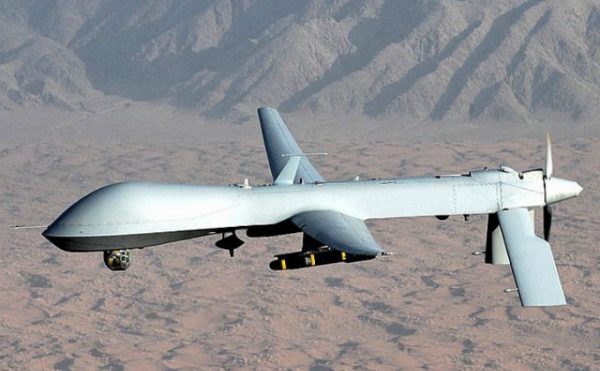
On Feb. 10, an Iranian drone that Israel says was armed with explosives was shot down over the Golan Heights, prompting an exchange of fire that saw Israeli fighter jets strike at the Syrian base the drone was launched from, while Syrian anti-aircraft defences shot down one of the attacking planes, which crashed just after it crossed back into Israeli airspace.
On April 8, Israeli jets − this time operating from Lebanese airspace − struck again, attacking another Syrian airbase, known as T-4. Seven Iranians were among the dead. Israel, in a break with past practice, acknowledged it was behind the strike. “It was the first time we attacked live Iranian targets − both facilities and people,” an unnamed military source told The New York Times.
Israel has signalled repeatedly that it will not allow Iran to continue building up its military infrastructure in Syria. The nightmare scenario for the Jewish state would be to see Iran take advantage of Syria’s civil war to replicate a Hezbollah-like force there, the same way it used the chaos of Lebanon’s wars in the 1980s to create the original.
Assaf Orion, a retired Israeli brigadier-general, recently told The Globe and Mail that any effort to confront Iran in Syria would almost certainly involve Hezbollah and Lebanon as well.
In Lebanon, Hezbollah leader Hassan Nasrallah has delivered his own warning. Israel, he said in a televised speech, had made a “historic mistake” by attacking T-4. Iran and Israel, he said, were now in “direct confrontation.”
Israel, which is on high alert amid celebrations to mark the country’s 70th birthday, announced this week that it was cancelling plans to send fighter jets to Alaska to take part in joint exercises with the United States, just in case the warplanes were needed on the home front.
While some analysts dismiss the rising rhetoric as bluster that neither side is likely to follow through on, Kamel Wazne, a Beirut-based expert on Hezbollah, said he believes the danger is real.
“What has happened in the past week to 10 days is very serious … my estimate is that war between [Israel and Iran] will happen, it’s just a matter of timing,” Mr. Wazne says. “And any miscalculation by either of these two entities will bring regional war to our area.”
The fragile peace along the Israel-Lebanon frontier is supervised by a 10,500-soldier UN force that first deployed here in 1978, and which saw its mission expanded after the 2006 war.
“We have to make sure on a daily basis that there is no escalation of tension,” says Andrea Tenenti, spokesman for the United Nations Interim Force in Lebanon, or UNIFIL. “The situation on the ground is stable now. But I wouldn’t call it peaceful.”
Hezbollah’s costly war
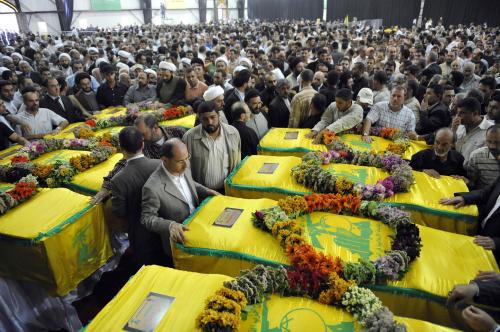
Lebanese analysts believe Mr. Nasrallah wasn’t initially keen on joining Syria’s war. The bearded 57-year-old cleric, who studied in Qom, Iran, and rose to power after his predecessor was killed in an Israeli air strike, prefers to portray himself as a regional, rather than a sectarian, leader − the only one willing to confront Israel over its occupation of Arab lands. Although its name means “Party of God,” Hezbollah often refers to itself simply as “the Resistance,” indicating its willingness to stand up to both Israel and its supporters in the West. Its flag features a hand clutching a Kalashnikov assault rifle.
Syria’s war has been sectarian from the moment it began in 2011, pitting Mr. al-Assad’s regime − which is dominated by followers of the Alawi faith, which is an offshoot of Shia Islam − against the country’s Sunni Muslim majority. In the eyes of many of the region’s Sunnis, Hezbollah reduced itself to just another Shia militia by wading into the morass of Syria.
Mr. Nasrallah likely felt he had no choice. The fall of Mr. al-Assad’s regime would have severed the route via which Iran supplies Hezbollah with weapons. It’s also unclear whether Mr. Nasrallah is allowed to say no to Iran, which has armed and funded Hezbollah since 1982, when it was established by a unit of Iran’s crack Revolutionary Guards who entered Lebanon via Syria
Hezbollah first made its existence known in the early 1990s with a wave of suicide car bombs against Israeli and U.S. targets, including an April, 1983, attack on the U.S. embassy in Beirut that killed 63 people.
Syria has been a costly war for Hezbollah. In addition to the political damage, the military wing is believed to have lost upward of 1,500 fighters. “Even the Shi[ites] themselves are not very keen on the war, because they are losing a lot of young people,” says Timur Goksel, a Turkish journalist who spent more than two decades working for the UNIFIL mission in Southern Lebanon.
But Mr. Goksel says many Lebanese also accept Hezbollah’s assertion that its intervention in Syria has kept the fight on that side of the border and that it prevented the Islamic State from bringing its jihadi carnage to Lebanon.
“There have supposedly been high costs of casualties, but [also] a high level of recruitment,” Mr. Wazne says. “The Shi[ites] accept the high costs because they feel that if Hezbollah did not go to Syria, the costs would have been higher.”
Challenging the ‘Party of God’
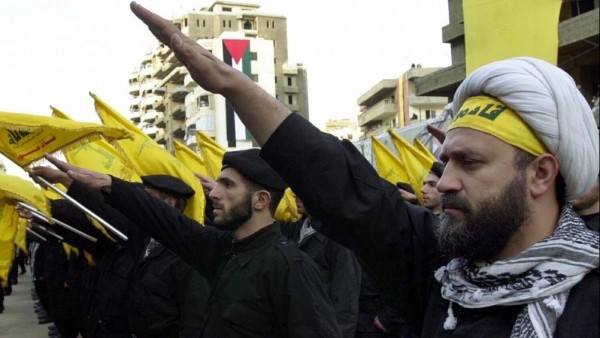
Riad al-Assaad has one of the most daunting political challenges anywhere. He’s running for office in Lebanon’s May 6 parliamentary election, facing off against Hezbollah in its Southern Lebanon stronghold.
Mr. al-Assaad has no illusions about how it will go. Lebanon’s new electoral law is expected to create cracks in the political order that emerged after the country’s own 1975-90 civil war − a system that remains dominated by sectarian-based political parties − by opening the door for more independent politicians to win seats in parliament. But nobody expects Hezbollah will lose its hold on the country’s Shias, who are estimated to account for somewhere between 1.2 million and two million of the country’s total population of 4.3 million. (Lebanon hasn’t conducted a census since 1932.)
“Of course, they are confident. They have a strong power base. The Shi[ites] are unified,” Mr. al-Assaad says when asked if he expects to defeat Hezbollah and its fellow Shia party, Amal. “But we are running to show that not all the people in the south are Amal or Hezbollah.”
The middle-aged Mr. al-Assaad, a Shiite who is running as part of a slate of independent candidates, walks a careful line in challenging the “Party of God.” Unlike some Sunni and Christian politicians − and their supporters outside Lebanon − he does not question Hezbollah’s need to retain its own militia separate from the Lebanese army.
The independents are running, he says, to highlight Hezbollah’s failure to help bring economic development to the country. Lebanon’s economic growth has slowed from 8 per cent in 2010, before the start of the war in Syria, to about 2 per cent last year. President Michel Aoun recently acknowledged that the country is awash in debt and risks bankruptcy.
Meanwhile, the country’s civil service has mushroomed in size as sectarian leaders reward their co-religionists with jobs in the ministries they control.
Hezbollah, Mr. al-Assaad says, could win over a lot of skeptical Lebanese if it used its political clout to tackle such corruption, especially as Mr. Nasrallah is viewed as one of Lebanon’s few clean political leaders. But while Hezbollah has held seats in parliament since 1992, it hasn’t sought to set the country’s economic agenda. Instead, Hezbollah lawmakers have largely served to ensure the movement maintains a veto over government decisions that might affect it.
Hezbollah went into politics primarily to protect the movement’s status as a heavily armed state within the state. A dozen years ago, after the war against Israel, some Lebanese politicians tried to press Hezbollah into giving up its weapons and leaving the country’s security to the Lebanese army.
After the group’s military successes in Syria, there’s no force in Lebanon strong enough to even raise the question any more.
“You’re not going to be able to fight Hezbollah and you shouldn’t fight Hezbollah. The question is how are we going to bring Hezbollah into the body politic?” Mr. al-Assaad asks. “This election, finally, everybody is saying, ‘We have no issue with your weapons, we have no issues with the resistance.’ We’re saying ‘who will create jobs? Who will deliver electricity?’ ”
/arc-anglerfish-tgam-prod-tgam.s3.amazonaws.com/public/CBCM3I5AUZHPNCGWNRWY4DV2E4.jpg)
A blanket of silence
The 2006 war is widely considered to have been a stalemate, a bloody one that left 165 Israelis and 1,300 Lebanese dead. Israel, however, fell short of its stated aim of eliminating the threat posed by Hezbollah and the arsenal of missiles it used to threaten cities such as Haifa and Tel Aviv.
It’s a conflict that changed how the “Party of God” works. After briefly courting foreign and Lebanese media − and winning some public-relations battles by highlighting the suffering of Lebanese civilians in the 2006 conflict − the movement has once again become a box that’s closed to outsiders.
Hezbollah’s media office in the Beirut neighbourhood of Haret Hreik was among the buildings destroyed in 2006, when Israeli warplanes battered the Shia-dominated southern suburbs of the Lebanese capital.
The suburb has been rebuilt, and so has the media office, which now sits above a hairdresser’s on the second floor of a non-descript apartment block. Plastic toys are visible on some of the neighbouring balconies.
But where foreign journalists could visit the prewar media office to request and receive interviews with senior members of the Hezbollah leadership (although not Mr. Nasrallah, who was in hiding even then), the new media office is there largely to collect business cards and passport copies from journalists − and then tell them the answer is no.
“We’ve found [dealing with media] didn’t work very well for us. It caused a lot of troubles,” explains Aya, a pleasant young woman in a headscarf who meets journalists in a room furnished with couches along all four walls. The only decorations are a red-white-and-green Lebanese flag and a yellow Hezbollah banner.
A blanket of silence has also descended over some of Hezbollah’s former critics. With Syria’s war creating fears of a spillover into Lebanon − where many Beirut buildings still bear the scars of bullets and heavier weapons fired during the civil war − the awkward peace that exists here is maintained largely by the knowledge that no other Lebanese force could hope to confront Hezbollah militarily.
“No one is powerful but Hezbollah. They have a monopoly on power,” says Selim Sayegh, a former Lebanese cabinet minister and a member of Kataeb, a Christian party. “They let the other parties play politically, in terms of the issues of the state, but all the issues that matter − defence, security, foreign affairs, the electoral law − are under the control of Hezbollah.”
Kataeb and Hezbollah have been on extreme opposite sides of Lebanon’s divide since the moment of the latter’s creation. When Israel invaded Lebanon in 1982, one of its objectives was to install a Kataeb president, hoping to see an Israel-friendly government on its northern border. The invasion turned into a two-decade Israeli occupation of Southern Lebanon, which in turn gave birth to Hezbollah.
Thirty-five years on from those events, Kataeb is a marginal force − and one of the few groupings still openly opposed to Hezbollah’s influence here.
Fear of Syria’s sectarian conflict spilling over Lebanon’s borders has led to an informal peace pact between the country’s main Sunni, Shia and Christian leaders. Barring a catastrophe, the elections will go ahead on May 6, but no one expects to see any change to the power-sharing agreement that sees Saad Hariri, a pro-Western Sunni politician, serving as the country’s Prime Minister, while Mr. Aoun, a Maronite Christian who has aligned himself with Hezbollah and Syria, remaining President. Nabih Berri, the head of the Shia Amal movement, will keep the parliamentary Speaker post he has held since 1992.
The peace pact has seen all sides make an effort to tone down their sectarian rhetoric.
Mr. Hariri’s father, the popular former prime minister Rafic Hariri, was killed in a 2005 car bombing, for which prosecutors at a special international tribunal in The Hague are trying four Hezbollah fighters in absentia. But even the younger Mr. Hariri rarely criticizes Hezbollah any more. In 2016, he gave into a long-standing Hezbollah demand and voted in favour of Mr. Aoun becoming President.
“Of course it’s dangerous to oppose Hezbollah,” says Mr. Sayegh, whose driver tries and fails to hide the fact that he has an assault rifle in the car with us as we drive through the Christian neighbourhoods of west Beirut. “You’re taking a risk by coming to see me.”
History repeating itself
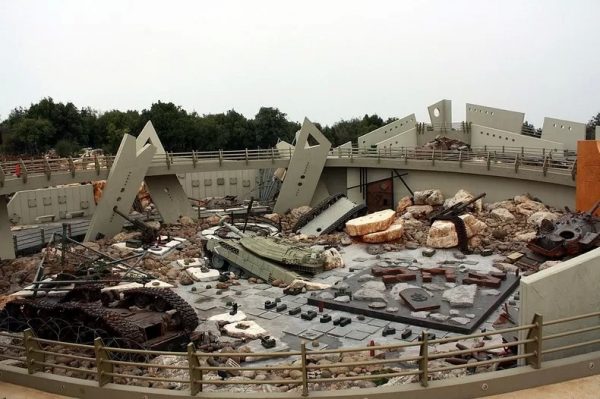
High on another hill in Southern Lebanon stands perhaps the best-maintained museum in the country.
Mleeta, which is dubbed “a touristic site about the resistance in Lebanon,” offers a one-sided tour of the region’s violent history. Visitors are told how “the Zionists” invaded Palestine in 1948 and then came to Lebanon again and again after that.
No reasons are given for the Israeli military actions, other than a desire to crush “the resistance.” (Israel invaded Lebanon in 1978 and 1982 to push the Palestine Liberation Organization away from its borders after a series of cross-border attacks; the 1996 and 2006 assaults were in response to provocations by Hezbollah.)
Hezbollah’s involvement in Syria gets no mention at all in the open-air museum, nor does the party’s long affiliation with Iran.
Visitors to Mleeta, which opened in 2010, are allowed to wander through tunnels and bunkers used by Hezbollah fighters and to peruse an exhibition of captured Israeli weapons, including the ID cards of Israeli citizens whose fates are unknown.
The entire museum − which includes a gift shop selling yellow Hezbollah flags and kitschy faux-grenade keychains − is guarded by Hezbollah security men in their trademark ballcaps and beige fatigues.
The exhibit is about the past, but visitors are also shown a 10-minute video that ends with Mr. Nasrallah making clear it could all happen again.
“If you bombard Rafic Hariri International Airport in Beirut, we will bombard Ben Gurion Airport in Tel Aviv,” the Hezbollah leader tells the camera. He’s dressed in his customary brown robes and his words are punctured by the angry waving of his right finger. “I announce this confrontation, and we and I all accept this confrontation.”
A 30 year-old tour guide named Mohammed appears after the movie is finished to ask if there are any questions. So, is Hezbollah worried − after the clashes in Syria –that war will come again to Lebanon?
“No one knows what will happen,” he says, before launching into a long diatribe about how it’s the United States and Israel who are responsible for Syria’s long civil war.
Behind him is the opening to a twisting path that takes visitors through a graveyard of captured and destroyed Israeli military equipment. The sign indicates that this part of the tour is called “the Abyss.”
“People anywhere want peace,” Mohammed continues, “but if war comes, we will fight.”
THE GLOBE AND MAIL
Leave a Reply
You must be logged in to post a comment.